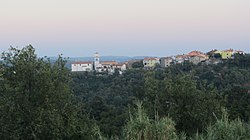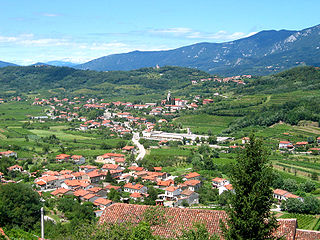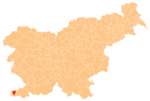| Korte Dvori nad Izolo (1957–1988) | |
|---|---|
 | |
| Coordinates: 45°29′19.87″N13°39′23.98″E / 45.4888528°N 13.6566611°E Coordinates: 45°29′19.87″N13°39′23.98″E / 45.4888528°N 13.6566611°E | |
| Country | |
| Region | Slovenian Littoral |
| Municipality | Izola |
| Area | |
| • Total | 4.95 km2 (1.91 sq mi) |
| Elevation | 201.5 m (661.1 ft) |
| Population (2002) | |
| • Total | 655 |
| [1] | |
Korte (pronounced [ˈkoːɾtɛ] ; Italian : Corte d'Isola) is a village in the Municipality of Izola in the Littoral region of Slovenia. [2]

Italian is a Romance language of the Indo-European language family. Italian, together with Sardinian, is by most measures the closest language to Vulgar Latin of the Romance languages. Italian is an official language in Italy, Switzerland, San Marino and Vatican City. It has an official minority status in western Istria. It formerly had official status in Albania, Malta, Monaco, Montenegro (Kotor) and Greece, and is generally understood in Corsica and Savoie. It also used to be an official language in the former Italian East Africa and Italian North Africa, where it plays a significant role in various sectors. Italian is also spoken by large expatriate communities in the Americas and Australia. In spite of not existing any Italian community in their respective national territories and of not being spoken at any level, Italian is included de jure, but not de facto, between the recognized minority languages of Bosnia-Herzegovina and Romania. Many speakers of Italian are native bilinguals of both standardized Italian and other regional languages.

Izola is an old fishing town and a municipality in southwestern Slovenia on the Adriatic coast of the Istrian peninsula. Its name originates from the Italian Isola, which means 'island'.

Slovenia, officially the Republic of Slovenia, is a sovereign state located in southern Central Europe at a crossroads of important European cultural and trade routes. It is bordered by Italy to the west, Austria to the north, Hungary to the northeast, Croatia to the southeast, and the Adriatic Sea to the southwest. It covers 20,273 square kilometers (7,827 sq mi) and has a population of 2.07 million. One of the successor states of the former Yugoslavia, Slovenia is a parliamentary republic and a member of the United Nations, of the European Union, and of NATO. The capital and largest city is Ljubljana.
















